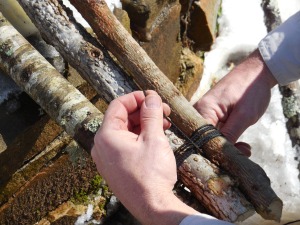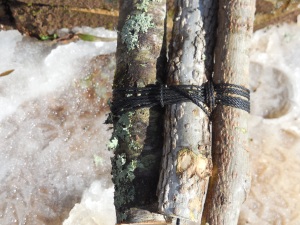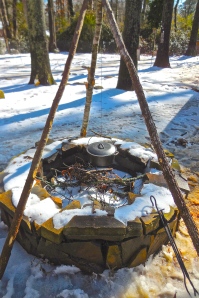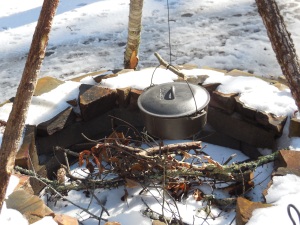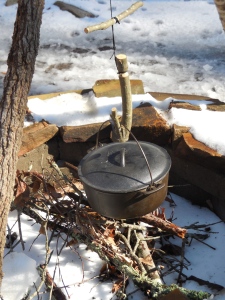| Online: | |
| Visits: | |
| Stories: |
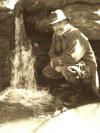
| Story Views | |
| Now: | |
| Last Hour: | |
| Last 24 Hours: | |
| Total: | |
How to Build a Bushcraft Tripod for Your Outdoor Kitchen
by Todd Walker
Southern Ice Storm Cooking Check List
- Propane cooker and fuel: √
- Camp stove and Coleman fuel: √
- Lump charcoal for the Green Egg: √
- EmberLit stove: √
- Firewood: √
We stock up on all these items in case of emergency events like the latest ice storm. Fortunately, we were without power for only three hours. Other Georgians didn’t fare as well.
Our Plan-B cooking methods were in place but were never called into action.
Today, cabin fever struck. I needed some back yard dirt time. What to do???
I know… make a tripod for our fire pit!
The first two emergency cooking fuels on my list are non-renewable. I’m sure I could make lump charcoal but not something I’ve done before. I don’t count on a method until I’ve practiced it. Always trading theory for ACTION!
Firewood is plentiful and gives us one more cooking option. Now I needed to build cooking equipment for our primitive outdoor kitchen.
Materials and Tools
Here’s what you’ll need to build your own sturdy cooking tripod:
- Three green saplings – each about 6 to 7 feet tall
- 20 feet of thin, strong cordage – tarred bank line works great (find it in Hunting and Fishing departments of box stores)
- Cutting tool to harvest saplings
Cut the three saplings and trim branches. The base of my trees were about forearm size with the tops about wrist size. Don’t discard the branches. You’ll use these resources later in your build.
Lay the saplings side by side. Tie a Timber Hitch with bank line onto the end of one of your poles. Here’s an animation for a tying a Timber Hitch.
For this application, skip the half hitches if you’re using tarred bank line. Fold over a 4 inch tag and twist the loop several times. Then pull the long tag line through the loop and cinch it tight about 4 or 5 inches from the top of one of your poles.
With poles laid flat, wrap three revolutions of cordage. Use a stick, screw driver, or attachment on your Swiss Army Knife to pull the loops tight. Now make three more passes and pull tight again. Keep the cord as tight as possible while keeping the poles side by side – don’t allow them to bunch together.
Next, thread the cordage between the first and second pole below the previous six wraps. Pull the cord up and over the top of the six cords. Repeat this until you have three revolutions around the six strands running perpendicular to your poles.
Tighten your cord every third wrap. You now have six wraps running horizontally with the poles. Tie off the tag on the sixth wrap with a half hitch.
Spread the poles out and set up over your fire pit. Mark where the ends meet the ground and fold your tripod back up. Place the poles on a wood anvil and trim the ends to a point for a better bite.
Re-install the tripod around your fire pit.
You should have a long tag of cordage dangling down the center of the tripod. Use this to hang cooking pots over the fire. If you don’t feel #36 bank line is sufficient, you could use a metal cable or small chain.
Toggle
Make a toggle out of one of the limbs from your sapling. I made mine about 8 inches long. Cut a notch in the middle and secure the bank line in the notch.
Slip the toggle through the wire handle to suspend the pot. You can adjust the pot height by looping the cordage over a pole stub at the top of the tripod.
Hook and Toggle
I also made a hook for the toggle system. Notch the top of the hook safely with a knife and tie a 12 inch piece of line around the notch. Tie a loop in the long tag end for your toggle stick to go through. This hook will allow you lower the pot close to the fire keeping the bank line farther away from the heat.
This set up is simple, sturdy, and functional. Wrap your tripod in a tarp or canvas drop cloth to smoke the thawing meat in your freezer. Just a thought.
Only thing missing is a few squirrels.
Keep Doing the Stuff,
Todd
P.S. – You can also keep up with the Stuff we’re Doing on Twitter, Pinterest, Google +, and our Facebook page. Trade theory for action and join us in the Doing the Stuff Network on these social media sites: Pinterest, Google +, and Facebook.
P.P.S ~ If you find value in our blog, DRG and I would appreciate your vote on the Top Prepper Sites! You can vote daily by clicking here or on the image below. Check out all the other value-adding Prepper Sites while you’re there…
Thanks for sharing the stuff!
Copyright Information: Content on this site (unless the work of a third-party) may be shared freely in digital form, in part or whole, for non-commercial use with a link back to this site crediting the author. All links in articles must remain intact as originally posted in order to be republished. If you are interested a third-party article, please contact the author directly for republishing information.
Source: https://survivalsherpa.wordpress.com/2014/02/14/how-to-build-a-bushcraft-tripod-for-your-outdoor-kitchen/








